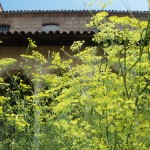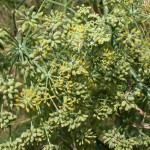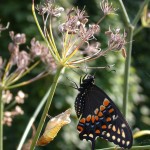Above, from left to right: Fennel flourishing in Bonnefont Cloister Garden in July; green fennel fruits ripening in late summer; umbels of dry fennel fruits at the end of the season.
Let us not forget to honor fennel. It grows
On a strong stem and spreads its branches wide.
Its taste is sweet enough, sweet too its smell;
They say it is good for eyes whose sight is clouded,
That its seed, taken with milk from a pregnant goat,
Eases a swollen stomach and quickly loosens
Sluggish bowels.?? What is more, your rasping cough
Will go if you take fennel-root mixed with wine.???From Hortulus by Walahfrid Strabo. Translated from the Latin by Raef Payne. The Hunt Botanical Library, 1966.
The ninth-century Benedictine abbot Walahfrid Strabo was a gardener as well as a scholar and a poet.?? He praises??the stately and beautiful fennel (Foeniculum vulgare) growing in his monastery garden??for its medicinal virtues, but fennel was also an ancient culinary herb, enjoyed both as a seasoning and a vegetable.
Indigenous to the Mediterranean, fennel was brought to England and Germany by the Romans, and to India and China by Arab traders.?? The Roman natural historian Pliny, writing in the first century, cites fennel in more than twenty remedies.?? All parts of the plant???roots, shoots,??leaves, and seeds???have been used both as food and as medicine.
The abundant anise-flavored??fennel??fruits (commonly called seeds)??are prized for their warm, sweet aroma, and can be used both fresh and dried. The finely divided leaves of fennel, described by Geoffrey Grigson as looking “like a tangle of green hair,”??do not dry well, and??are used fresh.?? Fennel leaves frequently appear in ancient and medieval cookbooks: the Roman cookbook writer Apicius gives a recipe for a sauce made with fresh fennel, and a fourteenth-century Italian recipe for chicken with fennel calls for the chopped “beards” of fennel and parsley (Odile Redon et al., The Medieval Kitchen: Recipes from France and Italy, 1998).
Fennel has a venerable reputation as a diet herb??and was??known to the ancient Greeks as Marathron, from the verb maraino, “to grow thin.”?? In the Middle English allegorical poem Piers Plowman, mention is made of?? “a farthing-worth of fennel for fasting days.”?? Fennel allayed hunger, and its culinary use as an accompaniment to fish made it an important seasoning??in the Lenten fare of the Middle Ages.?? Fennel is often included in modern herbal teas for dieting and weight loss. Its diuretic properties had already been recognized by the Greek herbalist Dioscorides, and Renaissance writers continued to praise fennel as an excellent remedy for those who had grown fat.
The six-foot plants that flourished all summer in Bonnefont Cloister Garden have now??gone to??seed, but are still impressive.??You won’t find them in either the medicinal or the culinary beds, but in the bed devoted to plants used in medieval magic and witchcraft.?? Believed to be a powerful amulet, fennel is invoked in the famous Lacnunga, or Lay of the Nine Herbs, an eleventh-century poem that names nine sacred worts to be used against “flying venom,” the principal agent of disease in the Anglo-Saxon world view.??These nine plants of power could also be used to free people or animals who had been “elf-shot” from their bewitchment.
???Deirdre Larkin
Tags: culinary herb, Fennel, Foeniculum vulgare, magical herb, medicinal herb




September 26, 2008 at 11:51 am
Fennel is one of those flavours that people either love or hate. Fortunately, I am of the former disposition! When was bulb fennel introduced?
October 7, 2008 at 3:43 pm
Dear Nicole—
Even though the fennel seeds on the plants out in Bonnefont Garden are past their prime, they are still delicious and I help myself to a few whenever I pass by.
Bulb fennel, known as Florence fennel or finocchio in the U.S. (although finocchio is the Italian designation for fennel in all its forms) belongs to the same species as the herb, Foeniculum vulgare, but is a distinct form known as F. vulgare dulce or F. vulgare azoricum. We don’t grow bulb fennel at The Cloisters. I suspect it dates to the Renaissance, like many other now-familiar vegetable forms, such as heading cabbages. A 16th-century Tuscan recipe in The Medieval Kitchen cited above gives instructions for combining ‘white’ fennel with leek, and for boiling and then frying fennel in oil, much the way bulb fennel is braised today. Even if Florence fennel were known in Italy at an earlier date, I doubt that it would have been familiar elsewhere in Europe until well after the Middle Ages.
October 13, 2008 at 10:41 am
Hello,
I have a question concerning another medicinal herb from the cloisters garden: the lesser calamint. I would like to know, which species of calamint is meant by this common name, since I found calmint only under names like calamintha grandiflora, - officinalis, - nepeta etc. Further I would like to know, where I can find seeds of this herb in its natural form. I only found seeds for large flowering garden species.
With very best regards,
Liv
October 26, 2008 at 4:22 pm
Dear Liv,
The calamint that you saw growing in the Medicinal Bed in Bonnefont Cloister Herb Garden is Calamintha nepeta, or lesser calamint. There are several ornamental cultivars of C. nepeta, including ???Blue Cloud??? and ???White Cloud.??? Both of these are grown in the Cuxa Cloister Garden, which includes modern forms of some medieval species as well as a good many garden plants unknown to the Middle Ages. The larger-flowered form, Calamintha grandiflora, is also grown as an ornamental, and there is a cultivar called ???Variegata??? with pink flowers and white variegation on the leaves.
According to the Royal Horticultural Society Index of Plants, which is our standard reference for taxonomy here at The Cloisters, Calamintha officinalis is no longer considered to be a distinct species, but is rather a subspecies of Calamintha nepetadesignated as C. nepeta ssp. glandulosa.
As the name ???officinalis??? indicates, the latter was an apothecary???s plant; it seems that the large and the small-flowered forms of C. nepeta were used interchangeably in medieval medicine to induce perspiration, prevent tremors and chills, cure skin ailments, and ease asthma and hysteria. (Frank Anderson, German Herbals through 1500, 1984.)
The lesser calamint is known in Tuscany as ???nepitella,??? and is the herb traditionally used to season porcini mushrooms. You can order seeds for lesser calamint from Sand Mountain Herbs at http://www.sandmountainherbs.com/nepitella_calamint_lesser.html